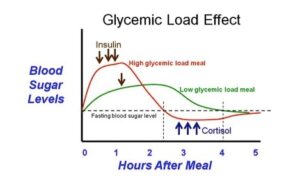Weight Loss, Wellbeing
How to keep fuller for longer
The key to getting or staying lean is controlling your insulin levels.
Insulin regulates your blood sugar level keeping it within a narrow range. Poor diet and lifestyle can lead to high levels of insulin which can cause a lot of a health problems.
When you eat carbohydrate, insulin is released from your pancreas. Once the sugar is absorbed into your blood, insulin deals with the excess and takes it to the cells of our liver, muscles and fat to help move the glucose inside to use as energy. The liver and muscles take what they need, and the rest is stored in our fat cells for future use.
The blood sugar rollercoaster
To understand the insulin AKA blood sugar rollercoaster its important to understand Glycaemic index and more importantly glycaemic load.
Glycaemic index
A rating of how much an individual food affects your blood sugar levels and therefore our insulin release.
Glycaemic Load
A rating of how a meal with portion sizes and food combinations taken into account affect your blood sugar levels and therefore your insulin release.
If you eat a meal with a high Glycaemic load your body releases insulin to deal with it. The sugar that is taken on board quickly is quickly processed by the insulin which can lead to a drop in blood sugar levels which brings a craving for more sugary foods.

The stress connection
Cortisol is the stress hormone. When your blood sugar is low a stress signal is sent to the brain. Cortisol is released to get sugar back into your blood. It is also released when the brain perceives some kind of danger, that can be a tiger attacking or a tough day at work.
We have 4 times more cortisol receptors in our abdominal fat than any other fat. Cortisol also stimulates appetite and the sugar you eat is stored as fat.
So, eating too much sugary food or being under some kind of stress will result in you having too much insulin in your system.
So how do we control insulin?
Get off the rollercoaster
Reduce sugar and refined carbs. Eating low Glycaemic Load meals. Avoid processed carbohydrates and ensure that meals are balanced and have Carbohydrate, protein, fat and fibre. Consuming balanced meals like this will help to slow insulin releases and lower the spike which will help you feel fuller for longer.
Eat protein
Always have protein in every meal as it will slow down the release of sugar, reduce insulin levels and keeping you full for longer. This in turn will reduce cravings for sugary foods. Here are some breakfast ideas to try:
- Eggs with spinach and salmon.
- Porridge with protein, peanut butter and seeds.
Eat fat
Fat is NOT the enemy. Fat is vital for many processes. It also reduces the insulin response from a meal. Any natural fats are ideal.
Combine Macronutrients
To blunt insulin release and reduce the chances of getting on the rollercoaster all meals should contain protein, fat and carbohydrate.
Reduce alcohol
Its full of sugar, has many negative effects on absorption of vitamins and leads to you making poor choices.
Don’t skip meals
Aim to start by eating 3 decent meals per day to hit your recommended macro intake. You can add in snacks if you wish and whilst different people will give you different approaches all backed by science, we think that the best approach is 3 meals with snacks between.
Get fit
Exercising helps insulin do its job efficiently so less needs to be released to deal with carbohydrate.
Relax and reduce stress
Reducing stress is super important for weight loss, high levels of cortisol will stop you getting really lean.
Sleep
Not getting enough sleep leads to increased release of the hormone Ghrelin. This hormone tells your brain you are hungry and will lead to you overeating.
Follow all of these tips, get insulin under control and reduce stress and you will stop cravings, eat better and get leaner faster.


